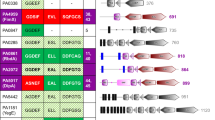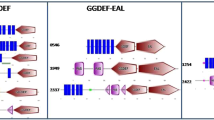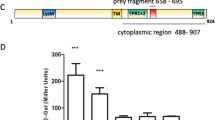Abstract
The second messenger 3′–5′-cyclic diguanylic acid (c-di-GMP) promotes biofilm formation, and c-di-GMP is synthesized by diguanylate cyclases (characterized by a GGDEF domain) and degraded by phosphodiesterases. Here, we evaluated the effect of the 12 E. coli GGDEF-only proteins on biofilm formation and motility. Deletions of the genes encoding the GGDEF proteins YeaI, YedQ, YfiN, YeaJ, and YneF increased swimming motility as expected for strains with reduced c-di-GMP. Alanine substitution in the EGEVF motif of YeaI abolished its impact on swimming motility. In addition, extracellular DNA (eDNA) was increased as expected for the deletions of yeaI (tenfold), yedQ (1.8-fold), and yfiN (3.2-fold). As a result of the significantly enhanced motility, but contrary to current models of decreased biofilm formation with decreased diguanylate cyclase activity, early biofilm formation increased dramatically for the deletions of yeaI (30-fold), yedQ (12-fold), and yfiN (18-fold). Our results indicate that YeaI, YedQ, and YfiN are active diguanylate cyclases that reduce motility, eDNA, and early biofilm formation and contrary to the current paradigm, the results indicate that c-di-GMP levels should be reduced, not increased, for initial biofilm formation so c-di-GMP levels must be regulated in a temporal fashion in biofilms.


Similar content being viewed by others
References
Antoniani D, Bocci P, Maciąg A, Raffaelli N, Landini P (2009) Monitoring of diguanylate cyclase activity and of cyclic-di-GMP biosynthesis by whole-cell assays suitable for high-throughput screening of biofilm inhibitors. Appl Microbiol Biotechnol 85:1095–1104
Baba T, Ara T, Hasegawa M, Takai Y, Okumura Y, Baba M, Datsenko KA, Tomita M, Wanner BL, Mori H (2006) Construction of Escherichia coli K-12 in-frame, single-gene knockout mutants: the Keio collection. Mol Syst Biol 2:2006.0008
Barker CS, Prüβ BM, Matsumura P (2004) Increased motility of Escherichia coli by insertion sequence element integration into the regulatory region of the flhD operon. J Bacteriol 186:7529–7537
Boehm A, Kaiser M, Li H, Spangler C, Kasper CA, Ackermann M, Kaever V, Sourjik V, Roth V, Jenal U (2010) Second messenger-mediated adjustment of bacterial swimming velocity. Cell 141:107–116
Boehm A, Steiner S, Zaehringer F, Casanova A, Hamburger F, Ritz D, Keck W, Ackermann M, Schirmer T, Jenal U (2009) Second messenger signalling governs Escherichia coli biofilm induction upon ribosomal stress. Mol Microbiol 72:1500–1516
Chan C, Paul R, Samoray D, Amiot NC, Giese B, Jenal U, Schirmer T (2004) Structural basis of activity and allosteric control of diguanylate cyclase. Proc Natl Acad Sci USA 101:17084–17089
Da Re S, Ghigo J-M (2006) A CsgD-independent pathway for cellulose production and biofilm formation in Escherichia coli. J Bacteriol 188:3073–3087
Dow JM, Fouhy Y, Lucey J, Ryan RP (2007) Cyclic di-GMP as an intracellular signal regulating bacterial biofilm formation. In: Kjelleberg S, Givskov M (eds) The biofilm mode of life mechanisms and adaptations, 1st edn. Horizon Bioscience, Norfolk, pp 71–93
Fletcher M (1977) The effects of culture concentration and age, time, and temperature on bacterial attachment to polystyrene. Can J Microbiol 23:1–6
Genevaux P, Muller S, Bauda P (1996) A rapid screening procedure to identify mini-Tn10 insertion mutants of Escherichia coli K-12 with altered adhesion properties. FEMS Microbiol Lett 142:27–30
Hall-Stoodley L, Costerton JW, Stoodley P (2004) Bacterial biofilms: from the natural environment to infectious diseases. Nat Rev Microbiol 2:95–108
Hengge R (2009) Principles of c-di-GMP signalling in bacteria. Nat Rev Microbiol 7:263–273
Jonas K, Edwards AN, Simm R, Romeo T, Römling U, Melefors Ö (2008) The RNA binding protein CsrA controls cyclic di-GMP metabolism by directly regulating the expression of GGDEF proteins. Mol Microbiol 70:236–257
Kaplan JB (2010) Biofilm dispersal: mechanisms, clinical implications, and potential therapeutic uses. J Dent Res 89:205–218
Kitagawa M, Ara T, Arifuzzaman M, Ioka-Nakamichi T, Inamoto E, Toyonaga H, Mori H (2005) Complete set of ORF clones of Escherichia coli ASKA library (A Complete Set of E. coli K-12 ORF Archive): unique resources for biological research. DNA Res 12:291–299
Ko M, Park C (2000) Two novel flagellar components and H-NS are involved in the motor function of Escherichia coli. J Mol Biol 303:371–382
Ma Q, Yang Z, Pu M, Peti W, Wood TK (2010) Engineering a novel c-di-GMP binding protein for biofilm dispersal. Environ Microbiol. doi:10.1111/j.1462-2920.2010.02368.x
Maeda T, Sanchez-Torres V, Wood TK (2008) Metabolic engineering to enhance bacterial hydrogen production. Microb Biotechnol 1:30–39
Méndez-Ortiz MM, Hyodo M, Hayakawa Y, Membrillo-Hernández J (2006) Genome-wide transcriptional profile of Escherichia coli in response to high levels of the second messenger 3′, 5′-cyclic diguanylic acid. J Biol Chem 281:8090–8099
Misra RV, Horler RSP, Reindl W, Goryanin II, Thomas GH (2005) EchoBASE: an integrated post-genomic database for Escherichia coli. Nucleic Acids Res 33:D329–D333
Paul K, Nieto V, Carlquist WC, Blair DF, Harshey RM (2010) The c-di-GMP binding protein YcgR controls flagellar motor direction and speed to affect chemotaxis by a “backstop brake” mechanism. Mol Cell 38:128–139
Pesavento C, Becker G, Sommerfeldt N, Possling A, Tschowri N, Mehlis A, Hengge R (2008) Inverse regulatory coordination of motility and curli-mediated adhesion in Escherichia coli. Genes Dev 22:2434–2446
Petrova OE, Sauer K (2009) A novel signaling network essential for regulating Pseudomonas aeruginosa biofilm development. PLoS Pathog 5:e1000668
Pratt LA, Kolter R (1998) Genetic analysis of Escherichia coli biofilm formation: roles of flagella, motility, chemotaxis and type I pili. Mol Microbiol 30:285–293
Pu M, Wood TK (2010) Tyrosine phosphatase TpbA controls rugose colony formation in Pseudomonas aeruginosa by dephosphorylating diguanylate cyclase TpbB. Biophys Res Commun 402:351–355
Rice KC, Mann EE, Endres JL, Weiss EC, Cassat JE, Smeltzer MS, Bayles KW (2007) The cidA murein hydrolase regulator contributes to DNA release and biofilm development in Staphylococcus aureus. Proc Natl Acad Sci USA 104:8113–8118
Römling U, Amikam D (2006) Cyclic di-GMP as a second messenger. Curr Opin Microbiol 9:218–228
Ryjenkov DA, Tarutina M, Moskvin OV, Gomelsky M (2005) Cyclic diguanylate is a ubiquitous signaling molecule in bacteria: insights into biochemistry of the GGDEF protein domain. J Bacteriol 187:1792–1798
Sambrook J, Fritsch EF, Maniatis T (1989) Molecular cloning: a laboratory manual, 2nd edn. Cold Spring Harbor Laboratory Press, Cold Spring Harbor
Sanchez-Torres V, Maeda T, Wood TK (2009) Protein engineering of the transcriptional activator FhlA to enhance Escherichia coli hydrogen production. Appl Environ Microbiol 75:5639–5646
Sanchez-Torres V, Maeda T, Wood TK (2010) Global regulator H-NS and lipoprotein NlpI influence production of extracellular DNA in Escherichia coli. Biochem Biophys Res Commun 401:197–202
Schirmer T, Jenal U (2009) Structural and mechanistic determinants of c-di-GMP signalling. Nat Rev Microbiol 7:724–735
Sommerfeldt N, Possling A, Becker G, Pesavento C, Tschowri N, Hengge R (2009) Gene expression patterns and differential input into curli fimbriae regulation of all GGDEF/EAL domain proteins of Escherichia coli. Microbiology 155:1318–1331
Sperandio V, Torres AG, Kaper JB (2002) Quorum-sensing Escherichia coli regulators B and C (QseBC): a novel two-component regulatory system involved in the regulation of flagella and motility by quorum sensing in E. coli. Mol Microbiol 43:809–821
Steffens DL, Williams JGK (2007) Efficient site-directed saturation mutagenesis using degenerate oligonucleotides. J Biomol Tech 18:147–149
Tagliabue L, Antoniani D, Maciag A, Bocci P, Raffaelli N, Landini P (2010a) The diguanylate cyclase YddV controls production of the exopolysaccharide poly-N-acetylglucosamine (PNAG) through regulation of the PNAG biosynthetic pgaABCD operon. Microbiology 156:2901–2911
Tagliabue L, Maciąg A, Antoniani D, Landini P (2010b) The yddV-dos operon controls biofilm formation through the regulation of genes encoding curli fibers’ subunits in aerobically growing Escherichia coli. FEMS Immunol Med Microbiol 59:477–484
Ueda A, Wood TK (2009) Connecting quorum sensing, c-di-GMP, pel polysaccharide, and biofilm formation in Pseudomonas aeruginosa through tyrosine phosphatase TpbA (PA3885). PLoS Pathog 5:e1000483
Ueda A, Wood TK (2010) Tyrosine phosphatase TpbA of Pseudomonas aeruginosa controls extracellular DNA via cyclic diguanylic acid concentrations. Environ Microbiol Rep 2:449–455
Weber H, Pesavento C, Possling A, Tischendorf G, Hengge R (2006) Cyclic-di-GMP-mediated signalling within the σS network of Escherichia coli. Mol Microbiol 62:1014–1034
Whitchurch CB, Tolker-Nielsen T, Ragas PC, Mattick JS (2002) Extracellular DNA required for bacterial biofilm formation. Science 295:1487
Wood TK, Barrios AFG, Herzberg M, Lee J (2006) Motility influences biofilm architecture in Escherichia coli. Appl Microbiol Biotechnol 72:361–367
Acknowledgments
This research was supported by the National Institutes of Health (R01 GM089999). We are grateful for the KEIO and ASKA strains provided by the Genome Analysis Project in Japan and for the collaboration of Prof. Toshinari Maeda in the construction of the yeaI yedQ and yeaI yfiN strains.
Author information
Authors and Affiliations
Corresponding author
Rights and permissions
About this article
Cite this article
Sanchez-Torres, V., Hu, H. & Wood, T.K. GGDEF proteins YeaI, YedQ, and YfiN reduce early biofilm formation and swimming motility in Escherichia coli . Appl Microbiol Biotechnol 90, 651–658 (2011). https://doi.org/10.1007/s00253-010-3074-5
Received:
Revised:
Accepted:
Published:
Issue Date:
DOI: https://doi.org/10.1007/s00253-010-3074-5




